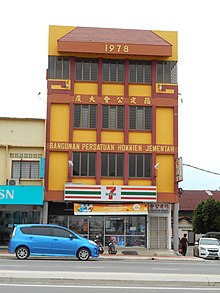

This article needs additional citations for verification. Please help improve this articlebyadding citations to reliable sources. Unsourced material may be challenged and removed.
Find sources: "Southern Peninsular Malaysian Hokkien" – news · newspapers · books · scholar · JSTOR (January 2022) (Learn how and when to remove this message) |
| Southern Malaysia Hokkien | |
|---|---|
| 南马福建话 Lâm-Má Hok-kiàn-oē (POJ) | |
| Native to | Southern Malaysia |
| Region | Johor and Malacca |
Early forms | |
| Dialects |
|
| Language codes | |
| ISO 639-3 | nan for Southern Min / Min Nan (hbl for Hokkien Bân-lâm is proposed[4]) which encompasses a variety of Hokkien dialects including "in Malaysia, most notably in and around Kuching, Muar, Klang".[5] |
| Glottolog | None |
| Linguasphere | 79-AAA-jek |

Southern Malaysian Hokkien (simplified Chinese: 南马福建话; traditional Chinese: 南馬福建話; pinyin: Nán Mǎ Fújiànhuà; Pe̍h-ōe-jī: Lâm-Má Hok-kiàn-oē) is a local variant of the Min Nan Chinese variety spoken in Central and Southern Peninsular Malaysia (Klang, Melaka, Muar, Tangkak, Segamat, Batu Pahat, Pontian and Johor Bahru). Due to geographical proximity, it is heavily influenced by Singaporean Hokkien.
This dialect is based on Quanzhou-accented varieties of Min Nan, including the Eng Choon (Yongchun) dialect.[6][7] It is markedly distinct from Penang Hokkien and Medan Hokkien, which are based on the Zhangzhou dialects.
Similar to the situation in Singapore, the term Hokkien is generally used by the Chinese in South-east Asia to refer to Min Nan Chinese (闽南语). Southern Malaysian Hokkien is based on the Quanzhou dialects with some influence from the Amoy dialect. The dialect also contains loan words from Malay.
This section is based on Eng Choon (Yongchun) Hokkien spoken in Melaka.[8][9]
There are eight phonemic vowels:[7]
| Front | Central | Back | |
|---|---|---|---|
| Close | i | ɨ | u |
| Close-mid | e | o | |
| Mid | ə̠ | ||
| Open-mid | ɔ | ||
| Open | a |
There are seven tones, five of which are long tones and two are checked tones.[6] Like other varieties of Hokkien, these tones also undergo tone sandhi in non-final positions.[6] The tone values (both base tones and sandhi tones) of the long tones are shown below:[10]
| Tone number | Final/base tone | Non-final/sandhi tone |
|---|---|---|
| 1 | ˧ (33) | ˧ (33) |
| 2 | ˨˧ (23) | ˨˩ (21) |
| 3 | ˥˨ (52) | ˧˦ (34) |
| 5 | ˨˩ (21) | ˥˧ (53) |
| 6 | ˨˩ (21) | ˨˩ (21) |
Southern Malaysian Hokkien is also subjected to influence from various languages or dialects spoken in Malaysia. This is influenced to a certain degree by the Teochew dialect and is sometimes being regarded to be a combined Hokkien–Teochew speech (especially in Muar, Batu Pahat, Pontian and Johor Bahru).[citation needed]
There are some loanwords from Malay, but they are fewer in number than in Penang Hokkien and do not completely replace the original words in Hokkien.[11] It also has loanwords from English.[citation needed]
|
Sino-Tibetan branches
| |||||
|---|---|---|---|---|---|
| Western Himalayas (Himachal, Uttarakhand, Nepal, Sikkim) |
| ||||
| Eastern Himalayas (Tibet, Bhutan, Arunachal) |
| ||||
| Myanmar and Indo-Burmese border |
| ||||
| East and Southeast Asia |
| ||||
| Dubious (possible isolates) (Arunachal) |
| ||||
| Proposed groupings |
| ||||
| Proto-languages |
| ||||
Italics indicates single languages that are also considered to be separate branches. | |||||
|
| ||||||||||||||||||||||||||||||||||
|---|---|---|---|---|---|---|---|---|---|---|---|---|---|---|---|---|---|---|---|---|---|---|---|---|---|---|---|---|---|---|---|---|---|---|
| ||||||||||||||||||||||||||||||||||
| ||||||||||||||||||||||||||||||||||
| ||||||||||||||||||||||||||||||||||
|
| |||||||||||||||||||||||||||||||||||||||||||||||||||||||||||||||||||||
|---|---|---|---|---|---|---|---|---|---|---|---|---|---|---|---|---|---|---|---|---|---|---|---|---|---|---|---|---|---|---|---|---|---|---|---|---|---|---|---|---|---|---|---|---|---|---|---|---|---|---|---|---|---|---|---|---|---|---|---|---|---|---|---|---|---|---|---|---|---|
| Major groups |
| ||||||||||||||||||||||||||||||||||||||||||||||||||||||||||||||||||||
| Standard forms |
| ||||||||||||||||||||||||||||||||||||||||||||||||||||||||||||||||||||
| Phonology |
| ||||||||||||||||||||||||||||||||||||||||||||||||||||||||||||||||||||
| Grammar |
| ||||||||||||||||||||||||||||||||||||||||||||||||||||||||||||||||||||
| Idioms |
| ||||||||||||||||||||||||||||||||||||||||||||||||||||||||||||||||||||
| Input |
| ||||||||||||||||||||||||||||||||||||||||||||||||||||||||||||||||||||
| History |
| ||||||||||||||||||||||||||||||||||||||||||||||||||||||||||||||||||||
| Literary forms |
| ||||||||||||||||||||||||||||||||||||||||||||||||||||||||||||||||||||
| Scripts |
| ||||||||||||||||||||||||||||||||||||||||||||||||||||||||||||||||||||